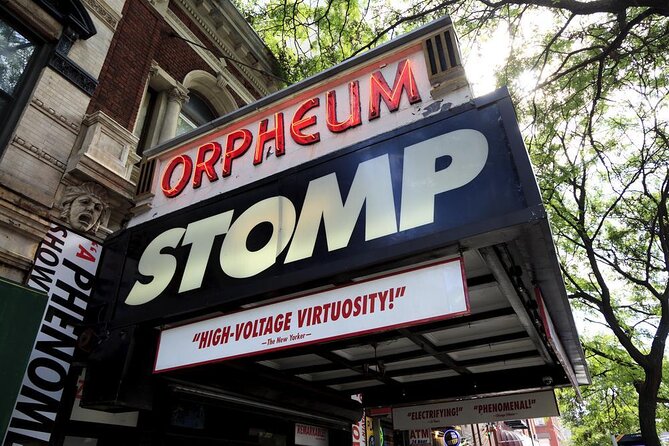Saluting Three Decades of ‘Stomp’ing in the East Village

We happily put up with the recurring smells and filth of New York City streets for the odd encounter with the surreal and the sublime. We find so thrilling the blurring of boundaries between noise and music, junk and art, danger and dance, that if someone put this otherwise randomly occurring street phenomenon up on stage, we’d pay to see it. As it happens, someone did put it up on stage right here in our neighborhood, and audiences paid to see it for almost thirty years. I’m referring, of course, to Stomp, which debuted in the East Village in 1994 and is about to conclude its tremendous run.
As most probably know, Stomp is a percussion/dance spectacle in which performers bang their way through an ominous, barebones industrial set using as instruments primarily streetside clutter.

Stomp’s punk sensibility always gave the impression that the show had emerged organically, perhaps on Avenue A, conceived by a late-night carousing drummer after stumbling into an obstructing trash can. As it happens, however, Stomp came to us from the other side of the Atlantic, courtesy of Steve McNicholas and Luke Cresswell, a pair of musicians from Brighton, England who, during the early 1980s performed as Pookiesnackenburger. This percussion-oriented street band busked outside the Edinburgh Fringe Festival, toured throughout Europe, opened for the transcendent ska-revival band Madness, and produced a beer commercial entitled “Bins” that displays the roots of the show that was to come.


The band broke up after a few years. But after a brief hiatus, during which Cresswell formed a “junk-percussion” duo, the metal-armor-clad members of which would beat each other with sticks, McNicholas and Cresswell got back together to embark on an ambitious new project.
As the percussionist of Pookiesnackenburger, Cresswell had gotten into the habit of using nearby street objects as substitutes for the drumming equipment that he couldn’t easily lug around with him; and he had noticed how enthusiastically audiences responded to his improvised instrumentation. With McNicholas, he now wondered whether this sort of experimental percussion approach could be extended into a full-length show. Being well-traveled veteran street performers, the two were already well-versed in the art of sustaining an audience’s interest and in doing so across language-barriers. So they drew from this experience to craft, along with a new eight-person troupe, a series of word-less, percussion-based skits into narrative shape. The result was Stomp, which opened in London to rave reviews in the summer of 1991. It then toured internationally for a few years, playing to sold out audiences around the world. And shortly thereafter, it landed in New York.
Stomp opened in February of 1994 at the storied Orpheum Theatre (formerly known as the Player’s Theatre), which had formed part of the Yiddish Rialto during the early 20th century.

Cresswell and McNicholas doubted that their show would make it through its initial four-month run. Their doubts, however, would prove ill-founded. Stomp soon became a smash with both audiences and critics, earning an Obie Award and a Drama Desk Award for Most Unique Theatre Experience and being hailed by New York Times critic Stephen Holden as “a solution to the garage crisis” (if only). During its three-decade run, the show grew well beyond its modest off-Broadway footprint, gradually became a pop cultural institution far and wide and a key element of the cultural landscape of the neighborhood. The Stomp cast has played or collaborated with local luminaries such as Paul Simon, Bill Irwin, the Harlem Globetrotters, and quintessential garbage can artist Oscar the Grouch; and it performed at the celebration of the new millennium hosted by President Bill Clinton. The stretch of Second Avenue that fronts the Orpheum Theatre was for a spell officially renamed Stomp Avenue. In honor of the show’s 10th anniversary, the mayor proclaimed a “Stomp Day”; and in honor of its 20th, the Empire State Building’s lights shone Stomp red and white.

Sadly, there will be no 30th anniversary celebration. On January 8, 2023, Stomp will end its improbable run, felled by flagging ticket sales never quite recovered from the impact of the pandemic and the decline in international tourism. In various ways, however, Stomp will live on. For one, touring companies will still be taking the show all over North America and Europe. For another, Stomp’s impact on the New York performance world has been and continues to be significant. One Stomp alumnus, modern and Irish step dancer Sean Curran, now heads the dance department at NYU’s Tisch School of the Arts (right across the street from the Orpheum Theatre). Another alumna, the incredible Michelle Dorrance, now leads her own eponymous company, which includes multiple other Stomp alumni and which regularly performs at the Joyce Theater. In the end, however, Stomp’s greatest legacy — as any dog who has had its head rhythmically petted after an owner’s night at the show will tell you — might just be the dissemination of the joyful John Cage-ian insight that any object can be an instrument and any noise can be a song. In that respect, the show will remain part of the East Village and continue to occasionally ennoble its gritty streets.

